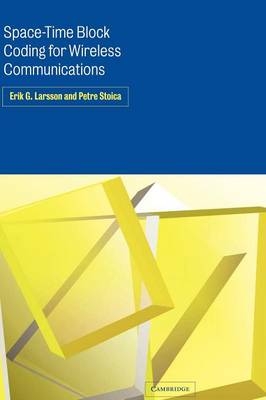
Space-Time Block Coding for Wireless Communications
Cambridge University Press (Verlag)
978-0-521-82456-9 (ISBN)
Space-time coding is a technique that promises greatly improved performance in wireless networks by using multiple antennas at the transmitter and receiver. Space-Time Block Coding for Wireless Communications, first published in 2003, is an introduction to the theory of this technology. The authors develop the topic using a unified framework and cover a variety of topics ranging from information theory to performance analysis and space-time coding methods for both flat and frequency-selective fading multiple-antenna channels. The authors concentrate on key principles rather than specific practical applications, and present the material in a concise and accessible manner. Their treatment reviews the fundamental aspects of multiple-input, multiple-output communication theory, and guides the reader through a number of topics at the forefront of research and development. The book includes homework exercises and is aimed at graduate students and researchers working on wireless communications, as well as practitioners in the wireless industry.
Erik G. Larsson received his PhD from Uppsala University, Sweden, and is an Assistant Professor of Electrical and Computer Engineering at the University of Florida, Gainesville. He has also worked as a research engineer at Ericsson Radio Systems in Stockholm. He is the author of some 20 technical papers and holds four US patents related to wireless communications. Petre Stoica received his PhD from the Bucharest Polytechnic Institute, Romania, and is a Professor of System Modeling at Uppsala University. He has held visiting positions at the Eindhoven University of Technology, Chalmers University of Technology, the University of Florida, and Stanford University. He has published 7 books, 10 book chapters, and some 500 technical papers. He is a Fellow of the IEEE, a Fellow of the Royal Statistical Society, and an Honorary Member of the Romanian Academy.
1. Introduction; 2. The time-invariant linear MIMO channel; 3. MIMO information theory; 4. Error probability analysis; 5. Receive diversity; 6. Transmit diversity and space-time coding; 7. Linear STBC for flat fading channels; 8. Linear STBC for frequency-selective channels; 9. Coherent and non-coherent receivers; 10. Space-time coding for informed transmitters; 11. Space-time coding in a multiuser environment; Appendices.
| Erscheint lt. Verlag | 8.5.2003 |
|---|---|
| Zusatzinfo | Worked examples or Exercises; 2 Tables, unspecified |
| Verlagsort | Cambridge |
| Sprache | englisch |
| Maße | 180 x 254 mm |
| Gewicht | 788 g |
| Themenwelt | Technik ► Elektrotechnik / Energietechnik |
| Technik ► Nachrichtentechnik | |
| ISBN-10 | 0-521-82456-7 / 0521824567 |
| ISBN-13 | 978-0-521-82456-9 / 9780521824569 |
| Zustand | Neuware |
| Haben Sie eine Frage zum Produkt? |
aus dem Bereich


